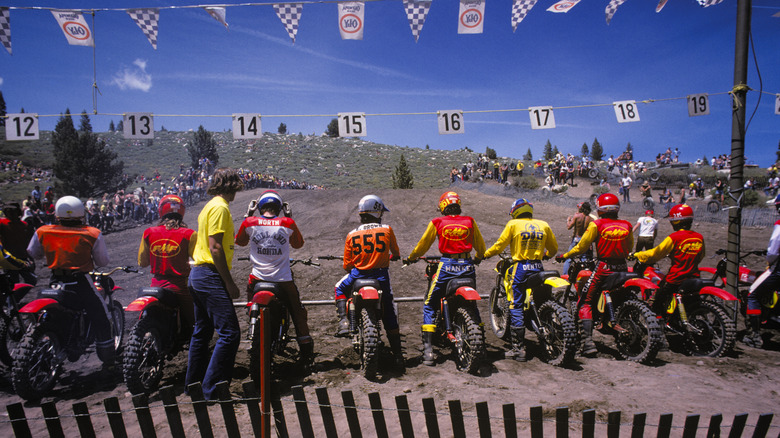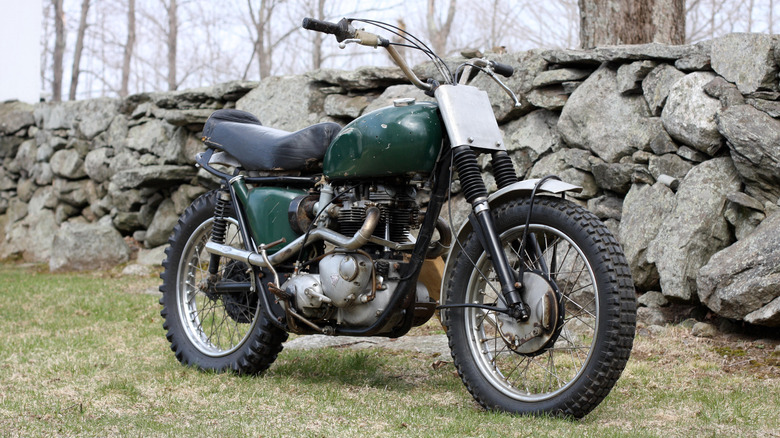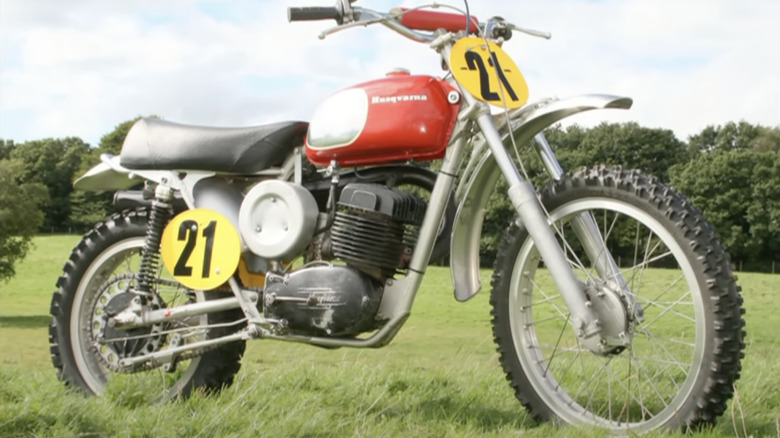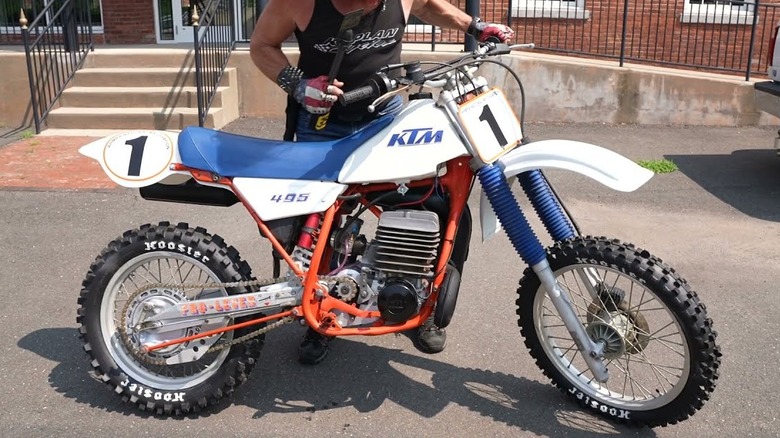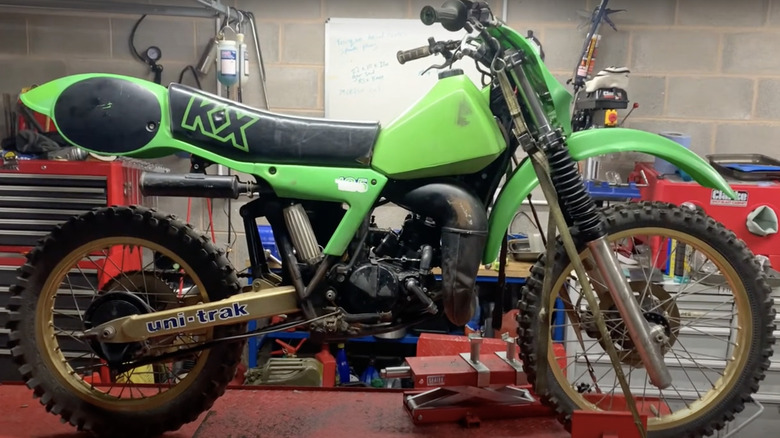10 Classic Dirt Bikes That Paved The Way For The Off-Road Motorcycles Of Today
It's hard to place when and where off-road motorbiking first came about, but it's a story that is likely as old as motorcycles themselves. These utilitarian machines have historically been used to access parts of the world unreachable on four wheels, and the vintage British marque BSA produced the first tailor-made dirt bike as early as 1914. Ten years later, the first official motocross event was held in Surrey, U.K., and by the 1950s, the sport was growing in popularity on both sides of the Atlantic.
Despite motocross's European roots, modern dirt bikes have significantly evolved since the 1960s, with the four great Japanese brands Honda, Suzuki, Kawasaki, and Yamaha dominating the industry. There has also been notable crossover, as motocross spawned the street-legal dual sport and enduro segments that have found popularity outside of motorsports among hobbyists, adventure riders, and even commuters.
While the success of the off-road motorcycle can't be attributed to a few particular models, a handful of bikes and innovations have certainly been instrumental in its evolution throughout the 20th century. The following are some of the trailblazing off-road machines that were the predecessors of the technically superior scrambler, dual sport, and enduro motorcycles we know today.
1955 Ariel 500 HS Motocross
Ariel was one of two major motorcycle manufacturers from Birmingham, England, alongside BSA. It was a respected brand founded in 1847 and was the manufacturer behind the popular Red Hunter and Square Four cruisers, as well as the HS series of motocross machines. However, BSA was one of the biggest bike brands in the world, and in 1951 it bought Ariel outright.The HS series continued to evolve under BSA's stewardship and by 1955 the first Ariel 500 HS Motocross rolled off the production line.
Looking at the Ariel 500 HS Motocross it is clear to see that as early as 1955 the modern motocross bike was taking shape. In profile, the high ground clearance, long-travel front forks, bash plate, straight-through exhaust, and knobby tires are all familiar features on almost every dirt bike. At the time, these relatively new innovations were modifications to the brand's street-legal and much heavier Ariel 500 HS model.
Unlike most modern motocross bikes, the 500 HS Motocross featured a four-stroke engine with a relatively large capacity of 497cc. The monoshock swingarm was also a long way off, as this was introduced by Yamaha in 1974, so the bike looks more of a hybrid between a classic cruiser and the dirt bikes we know today. Recognizable for its bright red fuel tank, the bike performed admirably in its day and quickly made a name for itself as the preferred bike among motocross and trials riders. It remains popular among collectors as a legendary machine that can fetch prices of over $20,000 at auction.
1963 Triumph Bonneville Desert Sled
SlashGear has previously written about the Triumph Bonneville as a reliable classic motorcycle that has periodically been in production in various iterations from 1959 to the present. Named after the Bonneville Salt Flats in Utah, where Triumph broke the land speed record in 1956, it has since become popular as a relaxed yet competent cruiser with timeless styling.
However, in 1963 the Triumph Bonneville was a seriously competitive machine, and the Desert Sled was a modified version of the rare T120C competition model optimized for desert races. It was to be ridden by none other than the legendary actor Steve McQueen, who was a longtime proponent of the British marque, and modified for the star by his friend Bud Ekins. Ekins was also a stunt performer, responsible for actually doing the famous motorcycle jump over the barbed wire fence in the movie "The Great Escape," one of the most impressive motorcycle stunts in movie history.
The Desert Sled was completely overhauled for competition, from its suspension and mufflers to its custom paint job. It was ridden by McQueen in the Mojave Desert and Baja California, which necessitated larger 19-inch front and 18-inch rear wheels and meant the frame had to be significantly rebuilt to accommodate these. The handlebars and seat were also custom additions, with leather hand grips for better purchase.
These extensive modifications made the Desert Sled truly one of a kind. It changed ownership after Steve McQueen passed away in 1980, and was since put up for auction by Bonhams, where it sold for over $100,000.
1965 Bultaco 250 Petite Metisse
The 1960s were a formative time for the motocross industry, particularly after a hopeful racer, Ernst Degner, defected from East Germany, bringing with him his knowledge of two-stroke engines. He signed for Suzuki in 1961, and the team won the next year's 50cc GP World Championship. It was the first of eight titles for the Japanese marque in that decade, cementing the viability of two-stroke technology in racing.
Lighter two-stroke engines also proved to be transformative for the off-road motorcycle industry in the early 1960s. Around this time, the Rickman brothers who were British importers of the Spanish brand Bultaco's motorcycles as well as professional motocross riders, took to modifying Bultaco bikes for competition. This led to their creating an entire rebuild using the Bultaco 250cc engine, which they dubbed the Petite Metisse, or "little mongrel."
The Petite Metisse was a competitive dirt racer, but Bultaco only gave its consent for it to be sold in the U.K. However, 24 units were covertly smuggled out of the country as parts by the aforementioned Bud Ekins and sold in the U.S., where they are considered to be highly collectible. The combination of the Rickmans' strong-but-light frames and much lighter two-stroke engines represented a sea change in the motocross industry, as off-road motorcycles were further becoming more lightweight and agile.
1968 Suzuki TM250
By the late 1960s, Japanese companies had been producing quality small-capacity engines for some time. Suzuki was one of the first to see the value in the single-cylinder two-stroke motocross engine, having been experimenting with various configurations since 1964. It settled on a single exhaust design, and in 1968 rolled out the TM250, the first Japanese production MX motorcycle, paving the way for the nation's brands to dominate the sport.
U.S. magazine Cycle World was one of the earliest reviewers to put the new motocross machine through its paces in March 1968, even though fewer than 50 units would be shipped Stateside that year. Its report was extremely positive, perceptively stating that Japan would likely find the same success with off-road racing as on the asphalt on the basis of this model alone. Other comments were enthusiastic, praising its high power output, impressive torque, and even its primitive (by today's standards) drum brakes.
At $975, the TM250 was the most expensive 250cc motorcycle on the market at the time, further cementing the fact that this was indeed a premium machine built for professionals. Motocross Grand Prix veteran Olle Pettersson was brought onboard to further optimize the racing model, and his lighter, torquier version found competition success in the hands of Gary Conrad, Walt Axthelm, and Preston Petty.
Most importantly, the TM250 was the catalyst for Japanese brands like Honda, Yamaha, and Kawsaki to launch their respective CR, YZ, and KX series of production motocross bikes. From the 1970s onwards, the industry would be changed forever.
1969 Husqvarna 400 Cross
Swedish brand Husqvarna had been working with two-stroke engines for a long time by 1969, as a major manufacturer of chainsaws and motorcycles. The brand had secured its first European MX Championship 10 years previously, winning a total of nine World Motocross Championship titles before 1970, leaving it well-poised to rival to the two-stroke machines of the Japanese "Big Four."
The 400 Cross was Husqvarna's 396cc two-stroke MX machine that took the early 1970s by storm. It was popular with the public, thanks in part to the motorcycle's famous use in the 1971 movie "On Any Sunday," ridden by Steve McQueen. By the following year, Husqvarna had ironed out some creases, altering the frame geometry for better handling and adding a fifth gear.
Cycle World ran a review of the 400 Cross in 1972, which was surprisingly in-depth and showed a good understanding of the requirements of motocross machines, even when they were in their relative infancy. It praised the motorcycle's off-road stability and handling, its positive transmission, and its aesthetics, with its recognizable orange and chrome gas tank.
The bike became a motocross and enduro racing icon, helped by McQueen posing with one on the cover of a 1971 Sports Illustrated magazine. Even without its Hollywood association, the Husqvarna 400 Cross is still one of the most coveted and collectible motorcycles within its segment, and McQueen's personal model recently sold at auction for a staggering $230,500.
1973 Honda CR250M Elsinore
No list of influential dirt bikes would be complete without Honda. The Japanese marque was relatively late to the party, releasing its first motocross machine, the CR250M Elsinore in 1973. Named after the motocross grand prix that was held annually in Lake Elsinore, CA, it was a commercially available competition model to rival the success of Yamaha, Kawasaki, and Suzuki. The Elsinore had a two-stroke 248cc single cylinder engine and was an early precursor to successful Honda off-road motorcycles like the XR250 and CRF250.
It's hard to imagine a time before Honda was a major player on the motocross stage. Yet, in the late 1960s it recognized that there was a growing trend for off-roading in the United States, and realized that the imported European bikes that were used in TT and Enduro races were prohibitively expensive for non-professional use. In true Honda style, it sought to bring motocross to the masses, just as it had done with motor scooters and its ubiquitous Super Cub, and the result was one of the best Honda motorcycles ever made.
The Honda CR250M Elsinore was well-built, affordable, and crucially, light and agile enough to handle the increasingly challenging circuits featured in motocross. Its reputation as the lightest production motorcycle made it incredibly popular from the get-go. The ad campaign spearheaded by Steve McQueen didn't hurt, either.
Meanwhile, its technical superiority to European counterparts, left marques like CZ, Maico, and Husqvarna scrambling to catch up at most races. The die had been cast, and Honda would be a permanent fixture in motocross from that moment on.
1975 Yamaha YZ250M
The Honda CR250M Elsinore left an indelible mark on the motocross industry, with its molded plastic fairings and aluminum and magnesium engine cases becoming industry standards. However, its compatriot Yamaha made a radical modification to the Elsinore's rival YZ250 that would change the profile of every dirt bike thereafter.
This particular ace up Yamaha's sleeve was its development of a monoshock suspension. Known as the "Monocross" (hence the "M" in YZ250M), it completely revolutionized frame geometry, providing far better performance and handling, and this was proven on the circuit. Just as the Elsinore's lightweight properties had left the competition for dust, the Yamaha YZ250M had once again rewritten the rule book with impressive results. Cycle World was quick to write a gushing review, simply stating: "If you can't win on this bike, you can't win."
On the face of it, the YZ250M looked much the same as the common YZ250, but in a sport where performance trumps raw power, the monoshock suspension made a considerable difference, and still does today. Unsurprisingly, the competition was quick to develop its own monoshock systems. Nowadays, it would be strange to see any sports-oriented motorcycle without one, whether on dirt or asphalt.
1981 KTM 495
Austrian brand KTM has been a major player in motocross motorcycle circles ever since it produced its first in-house two-stroke engine in 1972. The brand won its first Motocross World Championship in 1974, and has been a permanent fixture in two-wheeled motorsports since. By 1981 it was a seasoned marque with years of experience, much of which focused on off-road pursuits, and this was the year it released the KTM 495 to much acclaim.
The KTM 495 has a reputation that precedes it. It has been called the fastest dirt bike of all time, having been clocked at an impressive 123.75 miles per hour in independent testing in its inaugural year. As we have mentioned, dirt bikes are not designed for speed as much as they are performance, and it was never high on a manufacturer's agenda to produce one that could tip the speedometer over the 100-mile-per-hour mark. Yet here was this European bike that could not just to hit that mark, but exceed it by some margin.
While its speed was certainly impressive, the KTM 495 lived up to the hype in the dirt as well. It demonstrated excellent performance and handling, whether on the motocross circuit or enduro racing through Baja California, despite it being comparatively heavy within its class. KTM has continued to impress across many segments, from street bikes, to adventure bikes, to enduro bikes, to motocross machines, and with models like the 495 as part of its DNA, it's easy to see why.
1982 Kawasaki KX250
Veteran Japanese brand Kawasaki may not have been one of the earliest innovators of dirt bike technology, but in 1979 it invented the Uni-Trak shock, a game-changing suspension, based on the monoshock, where the shock sits vertically behind the swingarm pivot. This is now the most popular rear shock configuration in off-roaders, but Kawasaki was far from done.
Until the early '80s, one common feature on dirt bikes was their drum brakes. While these served their purpose, they were not as efficient as the disc brakes that featured on roadgoing bikes, such as the popular Honda CB750 Four, especially when wet. The main issue preventing the adoption of disc brakes on dirt bikes was their considerable size and weight. Kawasaki had flirted with the idea of disc brakes on a KX, but it wasn't until 1982, and the introduction of its KX250 that a refined, more compact solution was revealed.
This innovation was barely mentioned in Cycle World's contemporary review of the Kawasaki KX250, perhaps as the technology was still relatively new and took some getting used to. However, within three years, all major manufacturers were running disc brakes — albeit on the front wheels only — and by today, drum brakes have been all but consigned to history.
1997 Honda CR250R
As the precursor to the now ubiquitous CRF250, the CR250R was Honda's prominent racer in the 250cc class. However, for the 1997 season, it made a radical alteration to the CR250's frame that would herald a sea change in dirt bike construction, greatly improving their performance and handling.
Previously, tubular steel was the accepted material for frame construction, but with the 1997 CR250R, Honda took a leaf from the sport bike playbook and adopted an alloy perimeter frame. While Yamaha was an earlier adopter of this architecture in its factory bike construction, Honda was the first to use it in a production dirt bike, and it has continued to do so ever since.
The alloy perimeter frame not only considerably reduced overall weight, in this case weighing a full four pounds less than its predecessor, but it markedly improved performance. The improved lateral rigidity was palpable when tackling bumpy surfaces, and in conjunction with the rear Showa shock, absorbed impacts and vibrations. This helped alleviate rider fatigue, and was less likely to crack or show signs of wear over time.
While not all dirt bike brands use alloy perimeter frames in their motorcycles' construction, they are certainly in a minority, and the big four Japanese manufacturers all champion this design. Once again, Honda motorcycles were trailblazers, in this instance both literally and metaphorically.
